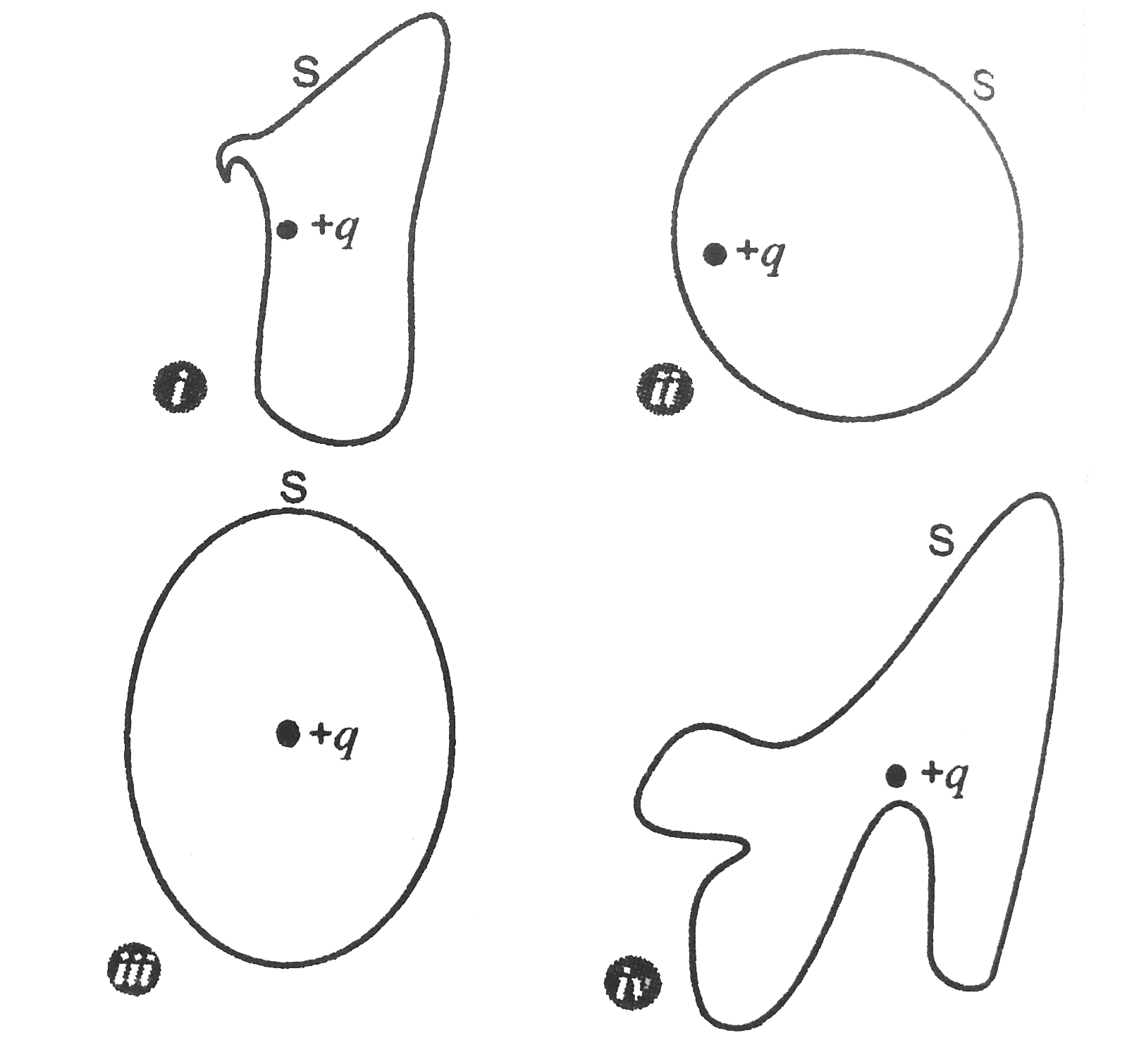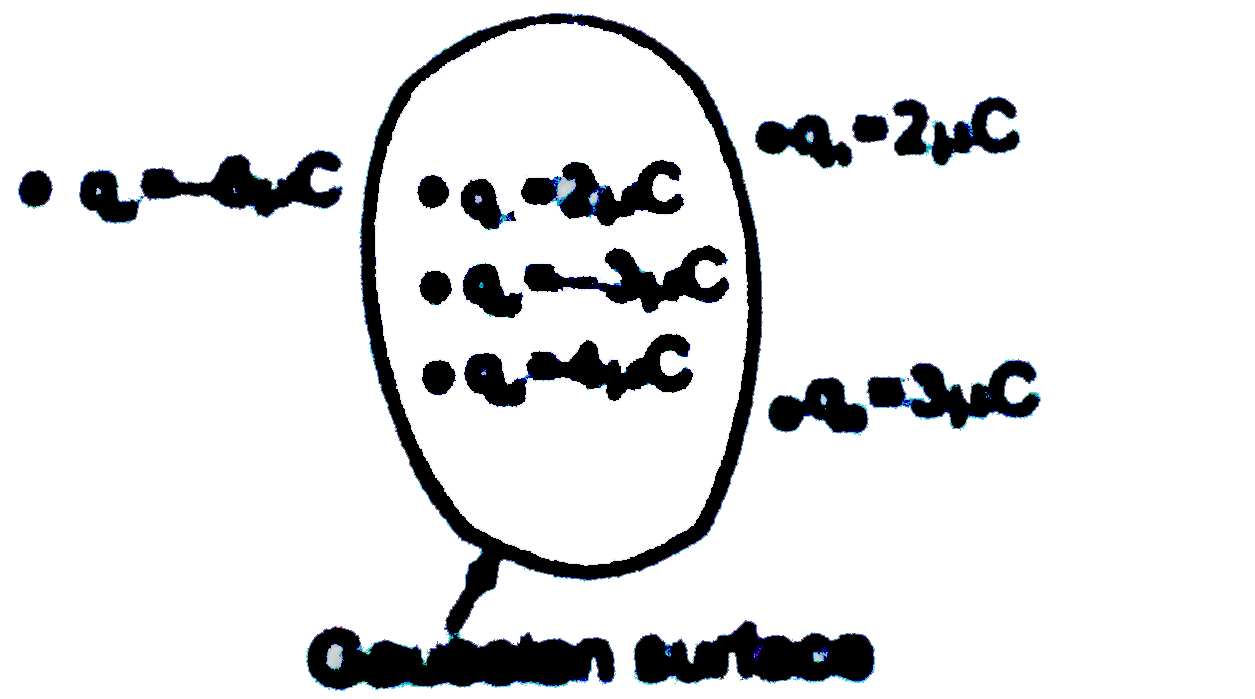A Gaussian surface encloses a proton p. The electric field at any point on the surface is . The flux linked with the Gaussian surface is .
STATEMENT-1 When an electron is kept close to this system outside the Gaussian surface, the flux linked with the surface would change.
and
STATEMENT-2 The presence of electron will alterthe electric field on the gaussian surface.
Statement-1 is True, Statement-2 is True, Statement -2 is a correct explanation for Statement-1
Statement-1 is True, Statement-2 is True, Statement-2 is NOT a correct explanation for Statement-1
Statement-1 is True, Statement -2 is False
Statement-1 is False, Statement-2 is True.
The correct Answer is:4
To solve the problem, we need to analyze both statements regarding the Gaussian surface that encloses a proton and the effect of placing an electron outside this surface.
1. Understanding the Gaussian Surface:
- A Gaussian surface is an imaginary closed surface used in Gauss's law to calculate electric fields. Here, the surface encloses a proton, which has a positive charge (+e).
2. Applying Gauss's Law:
- According to Gauss's law, the electric flux (Φ) through a closed surface is given by:
Φ=Qenclosedϵ0
- Since the Gaussian surface encloses only the proton, the enclosed charge Qenclosed=+e. Thus, the electric flux linked with the surface is:
Φ=+eϵ0
3. Analyzing Statement 1:
- Statement 1 claims that when an electron is placed outside the Gaussian surface, the flux linked with the surface would change.
- Since the electron is outside the Gaussian surface, it does not contribute to the enclosed charge. Therefore, the enclosed charge remains +e, and according to Gauss's law, the flux remains unchanged:
Φ=+eϵ0
- Thus, Statement 1 is false.
4. Analyzing Statement 2:
- Statement 2 states that the presence of the electron will alter the electric field on the Gaussian surface.
- The electric field at any point on the Gaussian surface is influenced by both the proton and the electron. The electric field due to the proton is directed outward, while the electric field due to the electron is directed inward (towards the electron).
- Therefore, the net electric field at the surface will be the vector sum of the electric fields due to the proton and the electron, indicating that the presence of the electron does indeed alter the electric field at the surface.
- Hence, Statement 2 is true.
5. Conclusion:
- Based on the analysis:
- Statement 1 is false.
- Statement 2 is true.
- Therefore, the correct option is that Statement 1 is false and Statement 2 is true.
Final Answer:
- Statement 1: False
- Statement 2: True
- A Gaussian surface is an imaginary closed surface used in Gauss's law to calculate electric fields. Here, the surface encloses a proton, which has a positive charge (+e).
- According to Gauss's law, the electric flux (Φ) through a closed surface is given by:
Φ=Qenclosedϵ0
- Since the Gaussian surface encloses only the proton, the enclosed charge Qenclosed=+e. Thus, the electric flux linked with the surface is:
Φ=+eϵ0
- Statement 1 claims that when an electron is placed outside the Gaussian surface, the flux linked with the surface would change.
- Since the electron is outside the Gaussian surface, it does not contribute to the enclosed charge. Therefore, the enclosed charge remains +e, and according to Gauss's law, the flux remains unchanged:
Φ=+eϵ0
- Thus, Statement 1 is false.
- Statement 2 states that the presence of the electron will alter the electric field on the Gaussian surface.
- The electric field at any point on the Gaussian surface is influenced by both the proton and the electron. The electric field due to the proton is directed outward, while the electric field due to the electron is directed inward (towards the electron).
- Therefore, the net electric field at the surface will be the vector sum of the electric fields due to the proton and the electron, indicating that the presence of the electron does indeed alter the electric field at the surface.
- Hence, Statement 2 is true.
- Based on the analysis:
- Statement 1 is false.
- Statement 2 is true.
- Therefore, the correct option is that Statement 1 is false and Statement 2 is true.
- Statement 1: False
- Statement 2: True
Topper's Solved these Questions
- ELECTRIC CHARGES AND FIELDS BOOK - AAKASH INSTITUTE ENGLISHCHAPTER - ELECTRIC CHARGES AND FIELDS EXERCISE - SECTION-F ( Matrix-Match Type Questions)
5 Videos
- ELECTRIC CHARGES AND FIELDS BOOK - AAKASH INSTITUTE ENGLISHCHAPTER - ELECTRIC CHARGES AND FIELDS EXERCISE - SECTION-G(INTEGER ANSWER TYPE QUESTIONS)
2 Videos
- ELECTRIC CHARGES AND FIELDS BOOK - AAKASH INSTITUTE ENGLISHCHAPTER - ELECTRIC CHARGES AND FIELDS EXERCISE - COMPREHENSION-II
3 Videos
- DUAL NATURE OF RADIATION AND MATTER BOOK - AAKASH INSTITUTE ENGLISHCHAPTER - DUAL NATURE OF RADIATION AND MATTER EXERCISE - ASSIGNMENT (SECTION-D)
10 Videos
- ELECTROMAGNETIC INDUCTIONBOOK - AAKASH INSTITUTE ENGLISHCHAPTER - ELECTROMAGNETIC INDUCTIONEXERCISE - ASSIGNMENT(SECTION -D) Assertion-Reason type Question)
15 Videos
Similar Questions
A surface encloses an electric dipole. The electric flux through the surface is
View SolutionAn arbitrary surface encloses a dipole. What is the electric flux through this surface ?
View SolutionThe electric flux through the surface

View SolutionThe electric flux through the surface

View SolutionThe electric flux through the surface

View SolutionThe Gaussian surface for calculating the electric field due to a charge distribution is
View SolutionWhich of the following is true for electric-flux through a Gaussian surface ?
View SolutionIf the flux of the electric field through a closed surface is zero,
View SolutionFind out flux through the given Gaussian surface.

View SolutionA surface enclosed an electric dipole, the flux through the surface is -
View Solution
